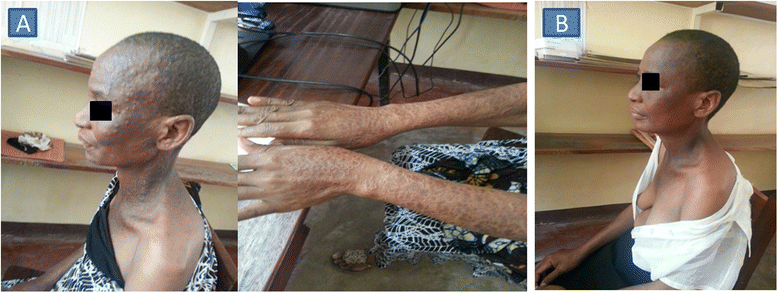Immune reconstitution inflammatory syndrome associated with dermatophytoses in two HIV-1 positive patients in rural Tanzania: a case report
- PMID: 27646953
- PMCID: PMC5029027
- DOI: 10.1186/s12879-016-1824-4
Immune reconstitution inflammatory syndrome associated with dermatophytoses in two HIV-1 positive patients in rural Tanzania: a case report
Abstract
Background: Immune reconstitution inflammatory syndrome associated with dermatophytoses (tinea-IRIS) may cause considerable morbidity. Yet, it has been scarcely reported and is rarely considered in the differential diagnosis of HIV associated cutaneous lesions in Africa. If identified, it responds well to antifungals combined with steroids. We present two cases of suspected tinea-immune reconstitution inflammatory syndrome from a large HIV clinic in rural Tanzania.
Cases presentation: A first case was a 33 years-old female newly diagnosed HIV patient with CD4 count of 4 cells/μL (0 %), normal complete blood count, liver and renal function tests was started on co-formulated tenofovir/emtricitabine/efavirenz and prophylactic cotrimoxazole. Two weeks later she presented with exaggerated inflammatory hyperpigmented skin plaques with central desquamation, active borders and scratch lesions on the face, trunk and lower limbs. Tinea-IRIS was suspected and fluconazole (150 mg daily) and prednisolone (1 mg/Kg/day tapered down after 1 week) were given. Her symptoms subsided completely after 8 weeks of treatment, and her next CD4 counts had increased to 134 cells/μL (11 %). The second case was a 35 years-old female newly diagnosed with HIV. She had 1 CD4 cell/μL (0 %), haemoglobin 9.8 g/dl, and normal renal and liver function tests. Esophageal candidiasis and normocytic-normochromic anaemia were diagnosed. She received fluconazole, prophylactic cotrimoxazole and tenofovir/emtricitabine/efavirenz. Seven weeks later she presented with inflammatory skin plaques with elevated margins and central hyperpigmentation on the trunk, face and limbs in the frame of a good general recovery and increased CD4 counts (188 cells/μL, 6 %). Tinea-IRIS was suspected and treated with griseofulvin 500 mg daily and prednisolone 1 mg/Kg tapered down after 1 week, with total resolution of symptoms in 2 weeks.
Conclusion: The two cases had advanced immunosuppression and developed de-novo exaggerated manifestation of inflammatory lesions compatible with tinea corporis and tinea facies in temporal association with antiretroviral treatment initiation and good immunological response. This is compatible with unmasking tinea-IRIS, and reminds African clinicians about the importance of considering this entity in the differential diagnosis of patients with skin lesions developing after antiretroviral treatment initiation.
Keywords: Case report; HIV; Immune reconstitution inflammatory syndrome.
Figures


References
-
- Ansari S, Hedayati MT, Zomorodian K, Pakshir K, Badali H, Rafiei A, et al. Molecular characterization and in vitro antifungal susceptibility of 316 clinical isolates of dermatophytes in Iran. Mycopathologia. 2015;14. - PubMed
-
- Colebunders R, Mann JM, Francis H, Bila K, Izaley L, Kakonde N, et al. Generalized papular pruritic eruption in African patients with human immunodeficiency virus infection. AIDS Lond Engl. 1987;1(2):117–21. - PubMed
Publication types
MeSH terms
Substances
LinkOut - more resources
Full Text Sources
Other Literature Sources
Medical
Research Materials

